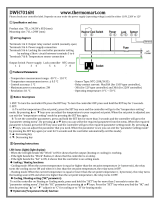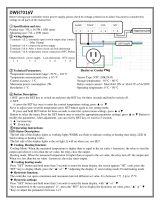
Ascon Tecnologic - KM2- Line - ENGINEERING MANUAL - PAG. 20
end, the instrument displays the Measured
value on the upper display and alternately
shows P.End and the value selected at
[120] L.dSP on the lower one.
P.t.td When the programmer is running, the display
shows the total remaining time (count down).
At program end, the instrument displays the
Measured value on the upper display and al-
ternately shows P.End and the value selected
at [120] L.dSP on the lower one.
ti.uP
When the timer is running, the display shows
the timer counting up. At count end, the instru-
ment, alternately shows t.End and the value
selected by [120] L.dSP on the lower display;
ti.du
When the timer is running, the display will show
the timer counting down. At count end, the in-
strument, alternately shows t.End and the value
selected by [120] L.dSP on the lower display;
PErc
Percent of the power output to be used dur-
ing soft start (when the soft start time is inF or
infinite, the limit is ever active and can be used
also when ON/OFF control is selected);
ct.on CT measure during ON;
ct.OF CT measure during OFF;
ct.iS Instantaneous CT measurement.
[120] L.dSP - Secondary Display Management
Available: Always.
Range: nonE Display OFF;
PV Measured value;
Pou Power output;
SPF Final Set Point;
Spo Operative Set Point;
AL1 Alarm 1 threshold;
AL2 Alarm 2 threshold;
AL3 Alarm 3 threshold;
Pr.tu • During a soak, the instrument shows the
elapsed time of the soak;
•
During a ramp the display shows the ope
ra-
tive Set Point. At program end, the instru-
ment displays the PV on the upper display
and alternately shows P.End and the value
selected at [120] L.dSP on the lower one.
• When no program is running, the instrument
shows the measured value.
Pr.td • During a soak, the instrument shows the
remaining time of the soak (count down);
•
During a ramp the display shows the operative
Set Point. At program end, the instrument dis-
plays the Measured value on the upper display
and alternately shows P.End and the value
selected at [120] L.dSP on the lower one.
• When no program is running, the instrument
shows the Standard display.
P.t.tu When the programmer is running, the display
shows the total elapsed time. At program
end, the instrument displays the Measured
value on the upper display and alternately
shows P.End and the value selected at
[120] L.dSP on the lower one.
P.t.td When the programmer is running, the display
shows the total remaining time (count down).
At program end, the instrument displays the
Measured value on the upper display and al-
ternately shows P.End and the value selected
at [120] L.dSP on the lower one.
ti.uP
When the timer is running, the display shows
the timer counting up. At count end, the instru-
ment, alternately shows t.End and the value
selected by [120] L.dSP on the lower display;
ti.du
When the timer is running, the display will show
the timer counting down. At count end, the in-
strument, alternately shows t.End and the value
selected by [120] L.dSP on the lower display;
PErc
Percent of the power output to be used dur-
ing soft start (when the soft start time is inF or
infinite, the limit is ever active and can be used
also when ON/OFF control is selected);
ct.on CT measure during ON;
ct.OF CT measure during OFF;
ct.iS Instantaneous CT measurement.
[121] di.CL - Display colour
Available: Always (not available on those controllers with
white display).
Range: 0 The display colour is used to show the actual
deviation (PV - SP);
1 Display red (fix);
2 Display green (fix);
3 Display orange (fix).
[122] AdE - Deviation for display colour management
Available: When [121] di.CL = 0 (not available on those
controllers with white display).
Range: 1... 9999 engineering units.
[123] diS.t - Display time out
Available: Always.
Range: oFF The display is always ON;
0.1... 99.59 minutes and seconds.
Note: This function allows to turn OFF the display when no
alarm is present and no action is made on the instru-
ment. When diS.t is different from oFF and no button
is pressed for more than the programmed time out,
the display goes OFF and only 4 segments of the less
significant digit are turned ON in sequence in order
to show that the instrument is working correctly. If an
alarm occurs or a button is pressed, the display will
come back to the normal operation.
[124] FiLd - Filter on the displayed value
Available: Always.
Range: oFF Filter disabled;
0.1... 20.0 engineering units.
Note: This is a “window filter” related to the Set Point, it is ap-
plied to the displayed value only and has no effect on the
other functions of the instrument (control, alarms, etc.).
[125] Reserved
[126] dSPu - Status of the instrument at Power ON
Available: Always.
Range: AS.Pr Starts in the same way it was prior to the
power down;
Auto Starts in Auto mode;
oP.0 Starts in manual mode with a power output
equal to zero;
St.bY Starts in stand-by mode.
Notes: 1. When you change the value of [127] oPr.E, the in-
strument forces [128] oPEr parameter equal to Auto.



























